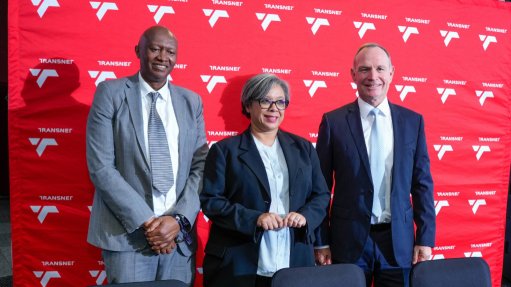More education initiatives needed in local industry



MICHEL BASSON Sassda offers various training programmes at technical and academic levels
NEED FOR STEEL Stainless steel consumption for the next 12 months is expected to be largely driven by demand in the automotive, food and beverage, and general engineering industries, with more demand also expected from construction of mining, water and transport infrastructure
Education and skills development remain indispensable for the South African stainless steel industry, however, the training and development of productive and skilled staff has become a “major stumbling block” to the growth of the industry, says Southern Africa Stainless Steel Development Association (Sassda) executive director Michel Basson.
While there was a high enrolment of students in Sassda’s training programmes from 2020 to 2022, owing to online classes being more accessible, there was a decline in uptake throughout 2023.
He attributes the decline to increased workloads that have made it difficult for employees working in the local sector to attend formal training sessions, and a less substantive employee pool relative to other industries.
“The role of any development association is to give the industry access to accredited and meaningful training that will address any hurdles. “The South African stainless steel industry makes up a small part of the broader steel industry, so we expected the numbers to eventually flatten out after having trained larger numbers of workers in the sector during the pandemic.”
Sassda offers various training programmes, including an introductory short course in stainless steel aimed at administrative staff and industry newcomers.
On the technical and academic level, it offers a fundamental and advanced course, accredited with a continuing professional development (CPD) rating, which covers the metallurgy of the different grades, as well as the properties, corrosion mechanisms, life-cycle costing and grade selection of stainless steel.
Sassda also offers CPD-accredited workshops to the architectural, construction, water and mining industries in online and in- person formats.
“Our courses and other training offerings can be customised and are aimed at educating and empowering people to sustain the growth of the local industry. We aim to provide training for people who may otherwise not have access to it, thereby increasing an individual’s sense of self-worth,” says Basson.
Sassda works closely with South African universities, and offers fundamental and advanced courses as part of various curricula.
The association presents workshops for architecture departments at universities and provides insights on industry requirements, as well as suggestions on how industry changes can impact on subject material in higher education.
Basson contends that collaborating with universities also plays a major role in helping to advance research and technological developments in the industry.
Hence, education, training and technical advice is critical in distributing industry information.
“By creating awareness around the use of local stainless steel cutlery and hollowware, for example, we can localise around 10 500 t of currently imported stainless steel products. This would mean around 30 000 to 50 000 potential new and sustainable jobs,” he notes.
Market Drivers
While the major market driver for stainless steel consumption used to be the export of locally produced stainless steel to Europe, Basson says exports have declined by about one-third since 2018, as a result of steel imports being capped in terms of non-European mills supplying the local industry.
“The medium-term prognosis for increased exports of locally produced stainless steel looks dim,” he laments.
The impact of these European Union (EU) trade restrictions, as well as the potential impact of EU-initiated carbon emission restrictions on imported steel products, will remain a threat on the global front, creating an expected 11% decline in the local steel industry.
Basson expects stainless steel consumption for the next 12 months to be largely driven by demand in the automotive, food and beverage, and general engineering industries, as well as infrastructure construction activities in the mining, water and transport sectors.
Moreover, to create a catalyst for the growth of local structural stainless steel product capacity, he says the industry relies on the projects identified in the Steel Masterplan.
This includes transmission towers being built by State-owned utility Eskom and rural steel bridges where 3CR12 stainless steel can be used in corrosive areas to lower life-cycling costs associated with using other metals.
There are also major efforts to localise products such as beer kegs and hollowware, which can create jobs.
Basson emphasises that a major focus in Sassda’s mandate is to push for growth in the volumes of stainless steel converted, or value added to the local industry.
To deliver on the mandate, he argues that it is necessary to increase the tonnage of stainless steel used locally, noting that the sector relies on the construction industry to increase the tonnage used.
“With 3CR12 included in the national standards for structural use in certain applications, State-owned entities, such as Transnet and Eskom, would have reason to use stainless steel in the construction of future transmission and electrification projects. This will grow our local capacity to produce structural profiles.
“Having these profiles locally available will open up new markets in the construction of mining, water and related infrastructure in Africa,” concludes Basson.
Article Enquiry
Email Article
Save Article
Feedback
To advertise email advertising@creamermedia.co.za or click here
Comments
Press Office
Announcements
What's On
Subscribe to improve your user experience...
Option 1 (equivalent of R125 a month):
Receive a weekly copy of Creamer Media's Engineering News & Mining Weekly magazine
(print copy for those in South Africa and e-magazine for those outside of South Africa)
Receive daily email newsletters
Access to full search results
Access archive of magazine back copies
Access to Projects in Progress
Access to ONE Research Report of your choice in PDF format
Option 2 (equivalent of R375 a month):
All benefits from Option 1
PLUS
Access to Creamer Media's Research Channel Africa for ALL Research Reports, in PDF format, on various industrial and mining sectors
including Electricity; Water; Energy Transition; Hydrogen; Roads, Rail and Ports; Coal; Gold; Platinum; Battery Metals; etc.
Already a subscriber?
Forgotten your password?
Receive weekly copy of Creamer Media's Engineering News & Mining Weekly magazine (print copy for those in South Africa and e-magazine for those outside of South Africa)
➕
Recieve daily email newsletters
➕
Access to full search results
➕
Access archive of magazine back copies
➕
Access to Projects in Progress
➕
Access to ONE Research Report of your choice in PDF format
RESEARCH CHANNEL AFRICA
R4500 (equivalent of R375 a month)
SUBSCRIBEAll benefits from Option 1
➕
Access to Creamer Media's Research Channel Africa for ALL Research Reports on various industrial and mining sectors, in PDF format, including on:
Electricity
➕
Water
➕
Energy Transition
➕
Hydrogen
➕
Roads, Rail and Ports
➕
Coal
➕
Gold
➕
Platinum
➕
Battery Metals
➕
etc.
Receive all benefits from Option 1 or Option 2 delivered to numerous people at your company
➕
Multiple User names and Passwords for simultaneous log-ins
➕
Intranet integration access to all in your organisation




















